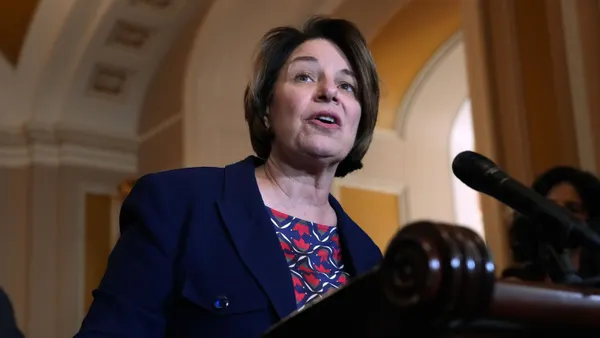Dive Brief:
- Norfolk Southern will work to further reduce its network to boost capital efficiency in the balance of the year, executives said on a Wednesday earnings call. The railroad idled two hump yards in the second quarter bringing the 2020 total to four. "We are continuing to optimize our train network and rationalize our yard network even while setting the stage for positive operating leverage as volumes rise," COO Mike Wheeler said.
- The railroad improved service metrics despite 26% loss of volume but lost ground in overall efficiency. Train speed was up 12% year over year and dwell was down 1% in the same period, but the operating ratio (OR) increased from almost 64% in Q1 to nearly 71% in Q2.
- The railroad is headed for a leadership shake-up as Wheeler plans to retire Oct 1. Cindy Sanborn, formerly VP of network planning covering the northeastern region of Union Pacific, will replace Wheeler. Sanborn was also formerly COO at CSX, where she worked in various capacities for 30 years. Sanborn will join Norfolk Southern Sept. 1.
Dive Insight:
Even before the pandemic, Norfolk Southern was showing some, but not all, of the results precision-scheduled railroading (PSR) often generates for railroads. The railroad has consistently reported gains in train speed and reductions in dwell time — two hallmarks of PSR. In fact, Norfolk Southern reported the greatest gains in speed between 2018 and 2019 of any U.S. Class I railroad with PSR principles in place. But OR, the overall mark of efficiency, wasn't decreasing in line with expectations.
Railroads improve OR most often by eliminating under-productive lanes, workers and equipment deemed extraneous. "We have been aggressively reducing our resources to meet our productivity goals," Wheeler said in October.
By January, OR hadn't budged much (64.9% in Q3 to 64.7% in Q4), but now-departing Wheeler still called the railroad's PSR execution "flawless." The railroad managed a larger decrease in Q1 — to 63.7% —promising a 25% spending cut for 2020. But a 70.7% OR in Q2 doesn't reflect the cuts.
Executives have pointed to the railroad's long term, "no surprise approach to PSR" as a reason for the lagging OR.
Union Pacific, where Sanborn most recently led competitive operations with Norfolk Southern, improved service metrics in the second quarter despite also experiencing a double-digit volume drop. And though the railroad's operating ratio increased to 61% in Q2, it is still significantly lower than that of Norfolk Southern.
"Cindy and I are very focused on maintaining the operational momentum that we have demonstrated in 2019 and in 2020. We together view this as an opportunity to continue to push hard on productivity," CEO Jim Squires said.
Sanborn is taking over operations just a few months after Squires pledged to push on PSR principals in order to maintain progress despite the pandemic volume drop — the bottom of which he forecasted would be in the second quarter. "That means crew start reductions going forward, a hard look at our yard and facilities network, blending more trains, the kind of step straight out of the PSR playbook to continue to drive down costs," Squires said in April.
The incoming COO will be tasked with managing Norfolk Southern's volume while maintaining capacity reductions.
"Any volume growth that comes here in the back half, we can absorb it with what we have, but also continue to look for more productivity opportunities," Wheeler said. Norfolk Southern has reduced its workforce by roughly 5,000 employees in the last year representing a 20% year-over-year reduction.
Just short of a month before the railroad announced Wheeler's retirement, Chief Strategy Officer John Scheib, who had strategic planning and network planning and optimization within his purview, stepped down effective June 1. Scheib's duties were integrated into other functions within the company, and the network elements will soon also fall to Sanborn.














